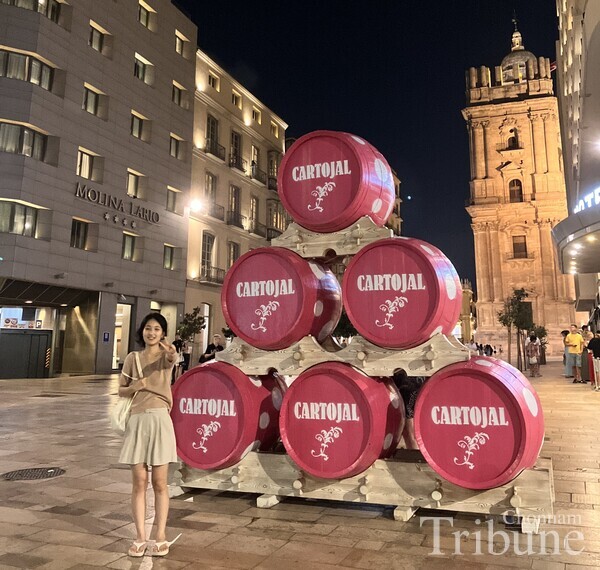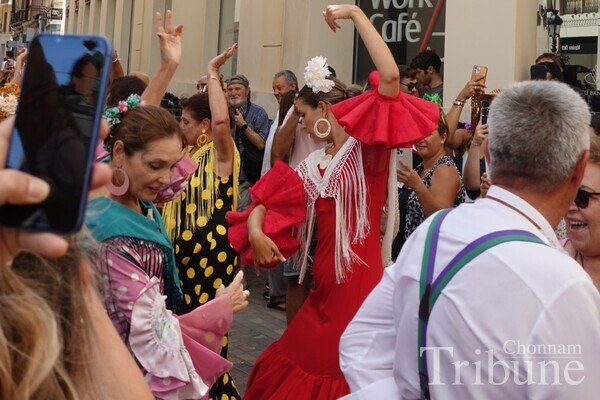
My decision to apply for an exchange program was quite impulsive, sparked by a chance encounter with a friend who had studied in Spain. I chose Spain not only because of my friend’s experience but also because I had seen the Alhambra Palace in the drama “Memories of the Alhambra” and really wanted to visit it. The mild climate of southern Spain also made it the perfect country for me. When I first arrived in Málaga, finding housing outside the university dorms was a major challenge, made necessary by the high cost of on-campus accommodation. I contacted countless lessors through real estate apps and visited several places before finally securing a room. At first, I also worried about making connections, especially since I stood out in a place where East Asian features were less common. However, through the Erasmus Student Network and buddy programs, I came to realize that the fundamentals of building relationships are the same everywhere in the world.
“The Vegetarian” on Stage
The University of Málaga offers a major in East Asian Studies and has active sisterhood ties with universities and institutions in South Korea, allowing for a wide range of cultural exchanges. One of the classes I took was called “Artes escénicas, danza y música en Corea”—a course on performing arts in Korea. The class was centered on performances related to Korean culture, and we worked in groups, which gave me many opportunities to bond with Spanish friends.
When Han Kang won the Nobel Prize during the semester, we had the opportunity to plan and perform a Spanish-language play based on “The Vegetarian.” The play rehearsals lasted for about a month. We divided the roles into narrators and physical performers. I volunteered for the narrator role and read the script alongside another Korean friend, while four Spanish friends narrated in Spanish. The main actors focused on delivering their lines with strong emotion. As narrators, we had to convey the emotions of the characters through our voices, experimenting with different tones and emphases. Although the play lasted only about 30 minutes, it was refreshing to express something through both physical actions and voice for the first time. Through the process of considering how to convey the message of “The Vegetarian” to the audience in both visual and auditory forms, I realized that theater is a far more comprehensive art form than I had previously thought.

Festive Rhythms of Everyday Life
Even within a short six-month period, I had chances to attend a number of festivals, which happened almost every month. The most memorable of them was the Feria de Málaga, held in August. This is a local festival in Málaga that lasts about a week in mid-August, during which the whole city becomes lively and festive. People drank a special type of alcohol produced exclusively for the festival, and I joined in dancing flamenco. The festival also showcased traditional elements of Spanish culture such as bullfighting and fireworks. I also remember attending a Málaga CF soccer match, where I accidentally ended up in the visiting team’s fan section and had to be escorted by the police. Watching the passionate fans made me reflect on the explosive power of sports.
Spain’s Cultural Fabric
Compared to the relaxed vibe of Andalusia, Madrid offered a strikingly different metropolitan atmosphere. While exploring the city, I especially enjoyed its art museums, where I could see everything from classical to modern works. Later, in Granada, I was thrilled to finally see the Alhambra Palace I had always dreamed of. Walking through its halls, I was amazed by the intricate craftsmanship and the traces of Islamic culture on the Iberian Peninsula. Barcelona felt like a paradise of Gothic and modern architecture. There, I experienced Gaudi’s genius and the harmony of nature in one place. The Basque Country in the north also left a strong impression. I went to see the Guggenheim Museum in Bilbao, but what struck me even more was the region’s history. Famously bombed during the Spanish Civil War and depicted in Picasso’s Guernica, the area now displays the painting with a Palestinian flag—a gesture of solidarity which deeply moved me. From Gaudi’s enchanting structures in Barcelona to the historical scars of the Basque, every region told its own story.

A Colorful Life in Spain
During the semester I spent in Spain, I found it to be a place where both the weather and the people were warm. Every time I returned from trips to other parts of Europe, I felt genuinely happy to be back, thanks to Spain’s mild climate. I was often touched by the kindness and warmth of the people, which made everyday life feel truly human. Of course, not every moment was perfect. But small acts of care and respect—like cars waiting for me to cross the street, the peaceful “siesta” hours under the midday sun, or the woman who calmly helped me when I was lost—gave me the chance to experience a slower, more mindful way of life.
From the Islamic-influenced south to the scenic mountains and fields of the north, from coastal towns to historic cities rich with royal heritage, Spain offers an incredible variety of landscapes, flavors, and lifestyles all within a single country. If anyone is considering moving to Spain, I wouldn’t hesitate to recommend it wholeheartedly.
By Im Ga-yeon, Senior, Dept. of Sociology

